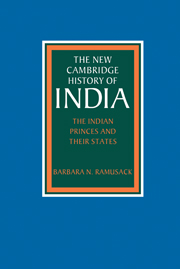Book contents
- Frontmatter
- 1 Introduction: Indian princes and British imperialism
- 2 Princely states prior to 1800
- 3 The British construction of indirect rule
- 4 The theory and experience of indirect rule in colonial India
- 5 Princes as men, women, rulers, patrons, and Oriental stereotypes
- 6 Princely states: administrative and economic structures
- 7 Princely states: society and politics
- 8 Federation or integration?
- Bibliographical Essay
- Glossary
- Index
- THE CAMBRIDGE HISTORY OF INDIA
- References
2 - Princely states prior to 1800
Published online by Cambridge University Press: 28 March 2008
- Frontmatter
- 1 Introduction: Indian princes and British imperialism
- 2 Princely states prior to 1800
- 3 The British construction of indirect rule
- 4 The theory and experience of indirect rule in colonial India
- 5 Princes as men, women, rulers, patrons, and Oriental stereotypes
- 6 Princely states: administrative and economic structures
- 7 Princely states: society and politics
- 8 Federation or integration?
- Bibliographical Essay
- Glossary
- Index
- THE CAMBRIDGE HISTORY OF INDIA
- References
Summary
Political chaos disrupts the status of many, but for others it provides opportunities for political advancement, social mobility and economic gain. During the eighteenth century the Mughal Empire, the largest, most extensive political organisation to evolve in India, suffered an attenuation of its power and its territory. Even so, the Mughal emperor continued to be a source of legitimacy through the bestowal of offices and titles, and Mughal patterns of administration and elite culture persisted in emerging states. Until the 1980s, historians taking a bird's-eye view from European and Mughal sources have often lamented the political turmoil and economic disruption during the eighteenth century. Only the expanding political power of the British supposedly created stable conditions. During more recent decades scholars have taken a worm's-eye view from the ground of local and regional records in Indian languages, and the political landscape of eighteenth-century India has been significantly altered.
Current scholarship indicates that while the Mughals may have been losing their power to accumulate economic resources and control the actions of subordinate personnel, new political formations emerged and implemented, with varying success, centralising reforms that would enable them to control the resources of the countryside more effectively than the Mughals had. These robust challengers were the successor states to the Mughals, most importantly Awadh, Bengal and Hyderabad, and warrior states, the creations of military entrepreneurs, more specifically Maratha states in the west, Mysore in the south and the Sikhs in the north. Other beneficiaries were Hindu trading groups such as Jagat Seths in Bengal and Marwaris from Rajasthan, who were forging interregional trade networks; and Muslim revenue farmers with contracts to collect revenue who amassed capital that they lent to aspiring indigenous kings and encroaching foreign commercial ventures, most notably the English East India Company.
- Type
- Chapter
- Information
- The Indian Princes and their States , pp. 12 - 47Publisher: Cambridge University PressPrint publication year: 2003

